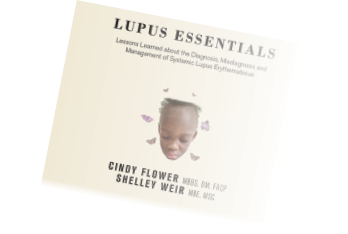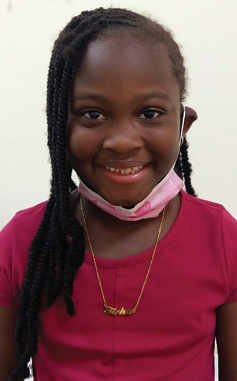
ANDREI ASKIRKA / shutterstock.com
For decades, rheumatologist Cindy Flower, MD, accumulated images of systemic lupus erythematosus (SLE) in her patients, as well as clinical vignettes to use in teaching at Queen Elizabeth Hospital in Bridgetown, Barbados. For decades, she has wanted to do something wide-reaching with these materials, sharing information from her practice and her mentor, the late Prof. George D. Nicholson, DM.
“Prof. Nicholson, an internist and nephrologist, managed hundreds of cases of lupus and developed an expertise in treating all aspects of the disease,” says Dr. Flower. “He inspired and encouraged me to specialize in rheumatology [because] there was no rheumatologist in Barbados.”
Dr. Flower recently used her information and expertise to co-author Lupus Essentials: Lessons Learned About the Diagnosis, Misdiagnosis and Management of Systemic Lupus Erythematosus. The booklet is an effort to help physicians diagnose and treat the disease, particularly as it presents in Black patients in the Caribbean, where patients may not have easy access to a rheumatologist. Lupus is two to three times more prevalent in Black women and women of color than in white women.1 Barbados is predominantly Black.2
Career
Born in Trinidad and Tobago, Dr. Flower moved to Barbados as a teenager. She graduated from the University of the West Indies (UWI) Medical School, Cave Hill campus, Barbados, where she also attended a postgraduate program for internal medicine. With Prof. Nicholson’s encouragement, she completed a rheumatology fellowship at the University of Minnesota, Minneapolis, and returned to Barbados to start the Rheumatology Clinic at Queen Elizabeth Hospital in Bridgetown, the island’s capital city. She is currently an associate consultant in rheumatology and a senior associate lecturer at the Cave Hill campus of UWI, teaching medical students and internal medicine residents.
“The rheumatology clinic was formally established in 1997,” she says. “I saw a broad range of very interesting rheumatologic diseases, and it was always clear that lupus was highly prevalent.”
‘In some parts of the world, you may be forced to treat for a presumptive diagnosis of lupus before you have all the supportive data that would make you comfortable. But you need to do it to save a patient’s life,’ Dr. Flower says.
She worked with Prof. Nicholson during her medical school education, internship and residency, as well as after returning from her fellowship. When he retired in 2002, she inherited his patients with lupus.
The Hope Foundation of Barbados, a nongovernmental organization that helps patients with SLE and other chronic diseases, published Dr. Flower’s booklet, which she co-authored with the foundation’s president, Shelley Weir. Dr. Flower sits on the Hope Foundation’s medical advisory board.
“I wanted to do something special [for the Hope Foundation’s 30th anniversary],” she says.
For All Practitioners

Featured on the booklet cover, Tishae Amya Evelyn was diagnosed with acute cutaneous lupus and alopecia in June 2020 at the age of 6.
The booklet includes information for rheumatologists in parts of the world where they don’t often treat Black patients and don’t have access to imagery that shows how lesions may differ in presentation on Black vs. white skin, as well as for primary care practitioners (PCPs), and covers case ascertainment, diagnosing lupus, principles in the management of lupus and life with lupus.
Although rheumatologists know the most common symptoms of SLE—painful, swollen joints, hair loss, rashes, mouth sores, fever and chest pain on deep breathing—the condition can mimic other diseases and may be tricky for specialists and PCPs alike to diagnose.
“Professor Nicholson’s mantra was always, ‘Young Black women of childbearing age with rheumatoid-like arthritis have lupus until proven otherwise,’” Dr. Flower says, adding that the best way to diagnose lupus is to simply to think of it and get familiar with the diverse ways in which it can present.
According to the publication, physicians considering a lupus diagnosis should be on the lookout for:
- A patient with any of the common symptoms, whether they occur concurrently or sequentially over time, and even with one resolving as another develops;
- A patient with an unexplained organ or system disorder, particularly if that patient is a young woman;
- A young (i.e., aged 15–40 years) patient with unprovoked thrombosis;
- A patient with proteinuria or impaired renal function, particularly a young (i.e., aged 15–40 years) female patient;
- A patient with a condition affecting more than one system of the body; and
- Any patient with an obscure diagnosis or presenting a diagnostic dilemma.
In Barbados, lupus is 14 times more common in women than men.3 So just being a woman is reason for the consideration of lupus in any of the above circumstances.
Delayed Diagnoses

Dr. Flower
The first three years of lupus are critical in terms of receiving treatment because serious complications, such as lupus nephritis and neuropsychiatric lupus, often occur during this time.4,5 According to Dr. Flower, patients with lupus who have had a delayed diagnosis tend to have had rashes that weren’t recognized as typical of lupus, joint pain that was attributed to minor random aches and pains, or proteinuria that was not expeditiously investigated.
“We want all doctors to consider the possibility of lupus in such cases,” Dr. Flower says. Based on her experience in clinical practice, she notes that young people of African origin, especially teenagers and persons in their early 20s who have developed proteinuria, are more likely to have SLE nephritis than renal complications of such diseases as hypertension and diabetes, which are easily ruled out.
Dr. Flower sees early treatment as so important that sometimes she treats a patient for SLE based on a good clinical diagnosis without waiting for results from serology tests, which in Barbados can sometimes take weeks to come back.
“In some parts of the world, a physician may be forced to treat with a presumptive diagnosis of lupus before having all the supportive data that bring reassurance. But that approach may be necessary to save a patient’s life,” she says.
Life & Lupus
Stress, pregnancy, parenting and poverty can all have a great impact on a patient diagnosed with lupus. Lupus Essentials balances current assessment and treatment options for lupus with these realities. “You can’t just manage the disease, you have to manage the patient,” Dr. Flower says.
Example: Dr. Flower discussed a young female patient she had with lupus nephritis. The patient, who wasn’t taking care of her health, showed up at the clinic with her toddler and said she thought she was having a nervous breakdown. The problem was, the patient couldn’t afford day care for her child, which distracted her from the management of her disease.
“She presented to my clinic with a social problem that needed to be addressed to allow her focus to return to managing her health,” Dr. Flower says. She referred her patient to a social worker and spoke with some nurses to find out how to help her patient find affordable day care.
“In a busy clinic, those tasks can feel burdensome, but they are all part of a physician’s duty to the patient.”
Renée Bacher is a health and medical writer based in Louisiana.
ACR Convergence 2021 Connection
This resource was discussed in the Nov. 3 session on Innovative Solutions to Global Challenges in Rheumatology. It’s not too late. Watch it on demand.
How to use Lupus to Interest Medical Students & Residents in Rheumatology
Lupus is a fascinating disease that can enrich your knowledge of internal medicine. I always tell medical students and residents that you can learn a lot of medicine from a patient with lupus because their complications are so diverse. When you’re comfortable assessing a patient with lupus, it makes you better in a whole lot of other aspects of medicine.
A lot of the clinical complications seen in lupus are not unique to lupus. Sometimes when a resident comes to the clinic, I can tell they’re not interested in rheumatology and are only here because they have no other choice. So I’ll ask what specialty interests them most.
If they say cardiology, I’ll say, “Let’s go through the cardiac manifestations of lupus.” If you get comfortable with all of the cardiac manifestations of lupus, it’s going to teach you different aspects of cardiology you’ll find interesting. Because a patient with lupus can get a pericardial effusion, I’ll ask, “What are the ECG manifestations of fluid around the heart?” If a resident learns that for lupus, they’ve learned it for all the other diseases that cause it.
If a resident tells me they’re interested in neurology, I let them know that lupus has 19 neuropsychiatric syndromes. So just by learning about what you need to know for lupus, it can extend to all different neurological diseases that may truly interest you.
One really does learn a lot of medicine—and a lot of clinical reasoning—just from assessing a patient with lupus. —Cindy Flower, MD
References
- Lupus facts and statistics: What is the impact of health disparities on people with lupus? Lupus Foundation of America. 2021.
- Demographics. Barbados Integrated Government. 2021
- Flower C, Hennis AJM, Hambleton IR, et al. Systemic lupus erythematosus in an African Caribbean population: Incidence, clinical manifestations, and survival in the Barbados National Lupus Registry. Arthritis Care Res (Hoboken). 2012 Aug;64(8):1151–1158.
- Flower C, Hennis AJ, Hambleton IR, Nicholson GD. Lupus nephritis in an Afro–Caribbean population: Renal indices and clinical outcomes. Lupus. 2006;15(10):689–694.
- Flower C, Hambleton I, Corbin D, et al. The spectrum of neuropsychiatric lupus in a Black Caribbean population: A report of the Barbados Lupus Registry. Lupus. 2017 Sep;26(10):1034–1041.
